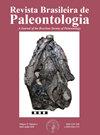巴西南部Santa Vitória组晚更新世鹳化石(锥锥目:锥锥科)及其古环境意义
IF 0.6
4区 地球科学
Q4 PALEONTOLOGY
引用次数: 5
摘要
巴西南部的鸟类化石记录很少,只有少数孤立的遗迹。这里描述了一种来自圣维多利亚组(SVF)哺乳动物遗骸组合的球虫化石。该标本的颈椎形态与现今巴西南部常见的麻瓜鹳相似。然而,它更大的尺寸表明,它可能是那个物种的形态型,也可能是另一个灭绝的物种。椎体的埋藏学修饰是由水生习性、形状、流水运输和浅水掩埋等多种因素共同作用的结果。发光测定的含化石沉积物沉积时间为晚更新世(37.9 ka b2k),其物理特征表明沉积物是在变流量和季节性地下水位振荡下沉积的。这些沉积物中水鸟的存在表明了一段降水增加的时期,这与南极冰芯记录的一个千年尺度的变暖脉冲(南极同位素极大值)的时间相关性,该脉冲表征了间冰期MIS 3。另一方面,随后的冰期MIS 2的干燥和寒冷气候可能迫使球虫和水生哺乳动物撤退到合适的地区(避难所),这表明它们在SVF上的黄土沉积物(Cordao组)中没有出现,直到全新世气候再次变湿变暖时才返回。本研究结果增加了巴西南部鸟类化石记录,有助于了解气候变化对南美洲南部第四纪时期球虫类鸟类和其他类群分布的影响。本文章由计算机程序翻译,如有差异,请以英文原文为准。
A Late Pleistocene fossil stork (Ciconiiformes: Ciconiidae) from the Santa Vitória Formation, Southern Brazil and its paleoenvironmental significance
The avian fossil record of southern Brazil is scarce, consisting of few isolated remains. Here is described a ciconiid fossil from the assemblage of mammalian remains of the Santa Vitoria Formation (SVF). The specimen is a cervical vertebra morphologically similar to Ciconia maguari (maguari stork), common in southern Brazil today. Nevertheless, its larger dimensions suggest that it could be either a morphotype of that species or another, extinct species. The taphonomic modifications of the vertebra result of a combination of autogenic and allogenic factors including the aquatic habit, shape and transportation by flowing water and burial in a shallow stream. The fossil-bearing sediment dated by luminescence was deposited during the late Pleistocene, at 37.9 ka b2k, and exhibits physical features indicating deposition under variable discharge and seasonal oscillations of the water table. The presence of an aquatic bird in these sediments indicates a period of increased precipitation, chronocorrelated to one of the millenial-scale warming pulses recorded in ice cores from Antarctica (Antarctic Isotope Maxima) that characterized the interstadial MIS 3. On the other hand, the dry and cold climate of the following glacial MIS 2 may have forced ciconiids and aquatic mammals to retreat to suitable areas (refugia), as indicated by their absence in the loess deposits (Cordao Formation) overlying the SVF, until returning during the Holocene when climate became wet and warm again. The results presented here increase the avian fossil record of southern Brazil and help understand the role of climate change on the distribution of ciconiid birds and other taxa during the Quaternary in southern South America.
求助全文
通过发布文献求助,成功后即可免费获取论文全文。
去求助
来源期刊

Revista Brasileira De Paleontologia
PALEONTOLOGY-
CiteScore
1.60
自引率
14.30%
发文量
25
审稿时长
>12 weeks
期刊介绍:
It publishes original contributions on all aspects of Paleontology. Papers are written in English, Spanish, or Portuguese and are reviewed by international experts.
 求助内容:
求助内容: 应助结果提醒方式:
应助结果提醒方式:


